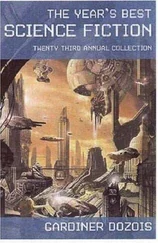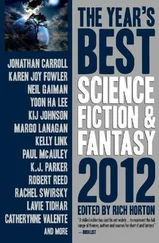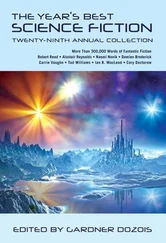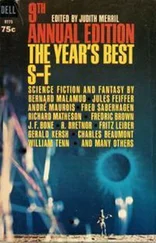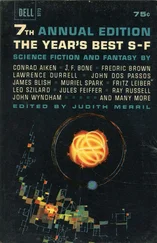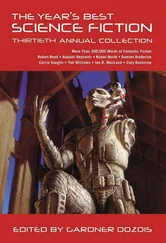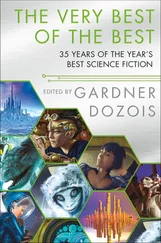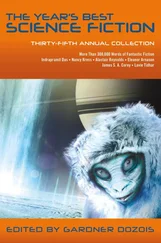Gardner Dozois - The Years Best Science Fiction, Vol. 20
Здесь есть возможность читать онлайн «Gardner Dozois - The Years Best Science Fiction, Vol. 20» весь текст электронной книги совершенно бесплатно (целиком полную версию без сокращений). В некоторых случаях можно слушать аудио, скачать через торрент в формате fb2 и присутствует краткое содержание. Жанр: Фантастика и фэнтези, на английском языке. Описание произведения, (предисловие) а так же отзывы посетителей доступны на портале библиотеки ЛибКат.
- Название:The Years Best Science Fiction, Vol. 20
- Автор:
- Жанр:
- Год:неизвестен
- ISBN:нет данных
- Рейтинг книги:5 / 5. Голосов: 1
-
Избранное:Добавить в избранное
- Отзывы:
-
Ваша оценка:
- 100
- 1
- 2
- 3
- 4
- 5
The Years Best Science Fiction, Vol. 20: краткое содержание, описание и аннотация
Предлагаем к чтению аннотацию, описание, краткое содержание или предисловие (зависит от того, что написал сам автор книги «The Years Best Science Fiction, Vol. 20»). Если вы не нашли необходимую информацию о книге — напишите в комментариях, мы постараемся отыскать её.
The Years Best Science Fiction, Vol. 20 — читать онлайн бесплатно полную книгу (весь текст) целиком
Ниже представлен текст книги, разбитый по страницам. Система сохранения места последней прочитанной страницы, позволяет с удобством читать онлайн бесплатно книгу «The Years Best Science Fiction, Vol. 20», без необходимости каждый раз заново искать на чём Вы остановились. Поставьте закладку, и сможете в любой момент перейти на страницу, на которой закончили чтение.
Интервал:
Закладка:
The year’s other heavy-hitter at the box-office was Spider-Man, which I suppose most people wouldn’t consider to be a fantasy movie, but which is certainly not a science fiction movie (or at least not a good one), as the “science” is complete nonsense-what it really is, of course, is a comic-book movie, practically a genre of their own, which straddle the borderline of both fantasy and science fiction, and play by their own aesthetic rules and their own brand of internal logic (which is why nobody ever realizes that Clark Kent looks exactly like Superman with glasses on). By the rules of real-world logic that the rest of us operate on, Spider-Man makes not a lick of sense, of course, but judged on its own terms, by comic-book aesthetics and comic-book logic, it’s a pretty good version of the adventures of perhaps the most famous superhero of all, after Superman and Batman. Spider-Man was always the comic of choice of intellectual nerds who got slammed up against lockers in high-school and laughed at in gym class, and the movie does a good job of capturing this part of the character’s appeal, with Tobey McGuire somehow managing to actually look like one of Steve Ditko’s drawings of the scrawny, squamulous, lopsided-headed Peter Parker in some of the early scenes. Even after the character’s transformation into a being with vast superpowers, when we’re deep into classic wish-fulfillment/Revenge Fantasy territory, McGuire does a good job of somehow letting us know that, deep inside the skintight costume and the bulging muscles, Peter Parker realizes that he’s still a loser no woman would touch with a stick-an intelligent job of acting. Spider-Man is the most successful film version of a comic-book, both critically and financially, since The X-Men, if not the original Tim Burton Batman, and not only has spawned a new franchise, with several sequels already in the works, but has sent producers scurrying to buy film rights to every comic-book they can find, no matter how obscure. So, like it or loathe it, there’s lot more of this stuff yet to come.
Things were less interesting on the science fiction side of the ledger. The most commercially successful of the year’s SF movies was also in some ways the most disappointing: Star Wars: Episode II-Attack of the Clones still managed to pack in the audiences, but was savaged critically, and, more significantly, didn’t get good word-of-mouth afterward from People who’d seen it, with even most stone Star Wars fans being unable to find anything more positive about it to say than “it was better than The Phantom Menace, anyway.” In spite of good special effects, evocative CGI-generated or augmented sets, wonderful costuming and set-dressing, and even a few good fight scenes (the light-saber battle between Yoda and Christopher Lee was a knockout, but unfortunately was good enough to make most of the rest of the movie look even more limp by comparison), this lack of enthusiasm Was not unearned-the dialog was awful, the storyline made even less sense than it had in The Phantom Menace (and twisted the backstory into even more contradictory knots), and the acting was so flat and wooden throughout, even from ordinarily good actors, that one finds it hard not to give some credence to the rumor that Lucas deliberately directs them to act that way. Hayden Christensen as Anakin Skywalker is an improvement over that creepy little kid from the previous movie, but his portrayal of the Darth-Vader-To-Be as a sullen, whiny, and sulky teenager, seemingly always on the verge of throwing a tantrum and holding his breath until he turns blue (“Why CAN’T I be the most powerful Jedi Knight? I WANNA be the most powerful Jedi Knight! You never let me do ANYTHING!”), lacks any sort of impact or conviction (his love scenes are enough to make a cat laugh), and drains the power from what, in the right hands, could have been an archetypically potent role. A review from The New York Times famously referred to Attack of the Clones as “a two-hour-and-12-minute action-figure commercial,” and, sadly, that largely sums it up.
Meanwhile, over at media SF’s other most famous franchise, things weren’t much better; in fact, in some ways, they were worse. The new Star Trek movie, Star Trek: Nemesis, didn’t do a lot better than Attack of the Clones with the critics (it did a little better: usually the reviews were lukewarm rather than scathing), and it did considerably worse at the box-office-not a total bomb, but certainly a disappointment, in terms of what they hoped it would draw, and what it cost to make. Again, even long-term, hardcore Star Trek fans seemed unexcited by it, and the movie generated little or no buzz even among media fans, let alone the general audience. Combined with the tepid performance of the current Star Trek television series, Enterprise, the mediocre performance of Star Trek: Nemesis is a major blow to the franchise, and radically decreases the chance of there ever being another Star Trek theatrical movie, as even the producers are ruefully admitting in public.
Minority Report and Signs, on the other hand, did make a lot of money, although I, finicky bastard that I am, was unimpressed with either. I liked Minority Report better than Signs- a sickly blend of science fiction and horror, freighted with an inspirational message about Faith and Redemption-but found it depressing that stories drawn from Philip K. Dick’s work, as Minority Report is, somehow always seem to come out more about car-chases, action scenes, and big explosions than about the intellectual/philosophical/mystical territory that Dick explored in such intricate and unsettling detail. Men in Black II was a limp sequel that managed to be not even half as much fun as the original, in spite of pumping in more special effects, more silly aliens, and lots more gags (fewer of which were really funny). Will Smith and Tommy Lee Jones do their best at being frenetic and charming, but they mostly just look tired, particularly Tommy Lee Jones, who looks throughout like he’s grumpy after being woken up from a long nap on the sofa. Solaris, the remake of the old Russian film version of Stanislaw Lem’s novel of the same name, was too lowbrow for the author, who criticized it sharply, and too highbrow for the viewing audience, who stayed away in droves. Reign of Fire had the last men on Earth earnestly fighting a plague of CGI dragons, rather than just instructing the special effects people to turn them off. And the latest Eddie Murphy vehicle, The Adventures of Pluto Nash, was such an enormous bomb that echoes of it are still washing back-and-forth between the Hollywood Hills, a sci-fi movie so bad that it makes you cry grateful tears to have something as good as Men in Black II to watch. And that was about it for science fiction films this year, live-action ones, anyway.
Two of the most successful films last year were animated features, Monsters, Inc. and (especially) Shrek, but this year’s animated films met with varying fates at the box-office. Disney’s Lilo and Stitch was very successful, both commercially and critically, a slightly edgier film (although, of course, still “warm-hearted” at base) then is usual from Disney, with vigorous and highly stylized-although somewhat crude-animation, lots of slapstick Roadrunner-style action, and a generous sprinkling of genuinely witty lines and incidental bits of business; it reminded me more of The Emperor’s New Groove from a few years back-loose-jointed and jazzy, with a lot of anachronistic, self-referential postmodern chops-than the standard non-Pixar Disney product. On the other hand, Disney’s Treasure Planet, a film with much more traditional Disney aesthetics, storytelling choices, and animation style, was a box-office disaster, especially considering how much it cost to make. The large number of direct-to-video quick-knockoff sequels of Disney classics that the studio cranked out this year- Peter Pan II, The Little Mermaid II, and so forth-didn’t seem to be setting the world on fire either. Coupled with the failure of last year’s traditional Disney animated feature, Atlantis, and the success of films such as Shrek, far ruder and cruder than the Disney average, I wonder if this doesn’t indicate that there’s been a fundamental shift in the taste of the audience. Kids who have grown up watching cartoons on Nickleodeon, stuff like SpongeBob and Dexter’s Laboratory and Rug-Rats and The Powerpuff Girls, may now want something edgier and hipper and zanier in their full-length animated movies than anything that Disney usually gives them. Ice Age also did well at the box-office and shared some of the same kind of self-referential postmodern humor as Lilo and Stitch or The Emperor’s New Groove, but I found it more heavy-handed and not as imaginative or engaging as either of those films. And the Japanese Spirited Away, aimed at an adult rather than a children’s audience, did very well with the critics, but was hard to find anywhere except in art-houses in the very biggest cities.
Читать дальшеИнтервал:
Закладка:
Похожие книги на «The Years Best Science Fiction, Vol. 20»
Представляем Вашему вниманию похожие книги на «The Years Best Science Fiction, Vol. 20» списком для выбора. Мы отобрали схожую по названию и смыслу литературу в надежде предоставить читателям больше вариантов отыскать новые, интересные, ещё непрочитанные произведения.
Обсуждение, отзывы о книге «The Years Best Science Fiction, Vol. 20» и просто собственные мнения читателей. Оставьте ваши комментарии, напишите, что Вы думаете о произведении, его смысле или главных героях. Укажите что конкретно понравилось, а что нет, и почему Вы так считаете.

